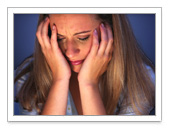
|
Follow Me On: |
 |
Kathleen Petty AVP/Sr Mortgage Originator Global Credit Union Home Loans AK#157293 Phone: (907)261-3458 Cell: 223-4440 Fax: (907)929-6699 License: NMLS Unique Identifier #203077 K.Petty@gcuhome.com https://www.globalcu.org/home-loans/resources/originators/Kathleen-Petty/ |
 | ||
| ||||
January 2008

|
Seasonal Affective Disorder: The Truth Behind the Winter Blahs
Winter can be a trying time of year. Between the harsh weather and the demands of the holidays, spring may seem like an oasis. Commonly referred to as the "winter blahs", symptoms during these months can include fatigue, general malaise, and depression, just to name a few. If this sounds familiar, you may be suffering from a condition known as Seasonal Affective Disorder. What is S.A.D.? One theory suggests that a lesser amount of sunlight diminishes the brain's production of Serotonin, a powerful neurotransmitter shown to regulate overall mood. A more popular theory states that a reduction of natural light causes the brain's pineal gland to overproduce the hormone Melatonin. While Melatonin happens to be a powerful antioxidant and crucial to our immune systems, it also regulates our "biological clock" as well as promotes sleep. In other words, neither a reduction nor an increase in melatonin levels is optimal. SAD is most common among residents of northern areas, where days are the shortest and daylight is at a minimum. It is also most prevalent in people between the ages of 20 and 40, although it's seen in both children and older adults. In addition, it seems to strike women more than it does men. Statistics show that SAD affects over 10 million Americans every year. Symptoms start with an inability to get out of bed in the morning, no matter how much sleep was obtained the night before. Throughout the day, lethargy and a lack of energy are common, and anything from a sense of gloom to abject depression can overtake an individual's overall mood. To make matters worse, one's appetite can increase along with cravings for high carbohydrate foods. A sufferer can also experience physical ailments such as headaches, heart palpitations, joint pain, sleep disorders, and even menstrual difficulties. The common denominator of all these symptoms is a potential to spiral. A lack of energy typically translates into a lack of production. As unfinished projects and tasks begin to pile up, depression sets in. Lethargy and depression, combined with an increase in appetite, eventually leads to weight gain and even deeper depression. From there, relationships can be affected and the downward spiral continues, even picking up speed. The Good News The following are a few examples of the behavioral changes that may help to chase away the winter blahs: Take a Proactive Approach Begin by learning more about Seasonal Affective Disorder. The Internet is a great source for information as well as support groups. There is also no shortage of books that deal specifically with the subject of SAD. The point is that the help is not going to come to you. Rather, you need to make the first move. Change the Way You Think Focus on Diet The second positive effect that the aforementioned diet will have is its ability to control any weight gain. Maintaining your weight throughout the winter months will improve the way you feel physically, maximizing your daily energy. It will also help the way you feel mentally. Let's face it; being in "swimsuit shape" in January never hurt anyone's ego. Focus on Exercise Take a Winter Vacation in the Sun Increase Your Indirect Exposure to Natural Sunlight Be Social Bright Light Therapy Vitamin Supplements If you are a person who has been experiencing the negative effects of SAD, we hope that this article has provided you a glimmer of hope. It should be comforting to know that there's a very real reason for the symptoms you've been experiencing during the winter months. Remember to stay positive and be proactive with your treatment. But, above all, look toward the light. | ||||||||||||||||||||||||||||||
License #AK157293 You are receiving a complimentary subscription to YOU Magazine as a result of your ongoing business relationship with Kathleen Petty. While beneficial to a wide audience, this information is also commercial in nature and it may contain advertising materials. INVITE A FRIEND to receive YOU Magazine. Please feel free to invite your friends and colleagues to subscribe. SUBSCRIBE to YOU Magazine. If you received this message from a friend, you can subscribe online. UNSUBSCRIBE: If you would like to stop receiving emails from Kathleen Petty, you can easily unsubscribe. Global Credit Union Home Loans AK#157293 |
, 125 W Dimond Blvd #110 Anchorage, AK 99515 Powered by Platinum Marketing © Copyright 2024. Vantage Production, LLC. | |||||||||


